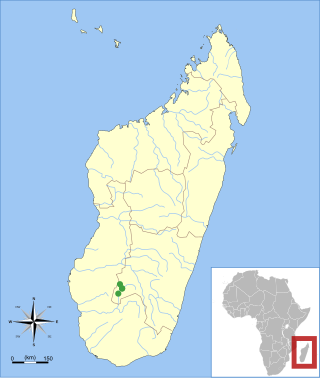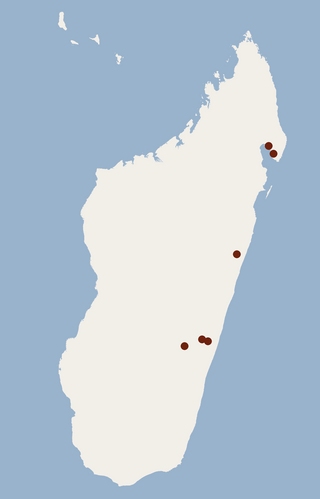
Anchieta's serotine, formerly known as Anchieta's pipistrelle, is a species of vesper bat. It is found in Angola, Democratic Republic of the Congo, South Africa, Zambia, Zimbabwe and Madagascar. The species inhabits savanna habitats.
The dark-brown serotine is a species of vesper bat found in Central and West Africa.

Zombitse-Vohibasia is a national park in the Atsimo-Andrefana region of south-west Madagascar. It is 147 kilometres (91 mi) north-east of the town of Toliara on the National road 7.

Pipistrellus raceyi, also known as Racey's pipistrelle, is a bat from Madagascar, in the genus Pipistrellus. Although unidentified species of Pipistrellus had been previously reported from Madagascar since the 1990s, P. raceyi was not formally named until 2006. It is apparently most closely related to the Asian species P. endoi, P. paterculus, and P. abramus, and its ancestors probably reached Madagascar from Asia. P. raceyi has been recorded at four sites, two in the eastern and two in the western lowlands. In the east, it is found in open areas and has been found roosting in a building; in the west it occurs in dry forest. Because of uncertainties about its ecology, it is listed as "Data Deficient" on the IUCN Red List.

The Isalo serotine is a vesper bat of Madagascar in the genus Laephotis. It is known only from the vicinity of the Isalo National Park in the southwestern part of the island, where it has been caught in riverine habitats. After the first specimen was caught in 1967, it was described as a subspecies of Eptesicus somalicus in 1995. After four more specimens were collected in 2002 and 2003, it was recognized as a separate species. Because of its small distribution and the threat of habitat destruction, it is considered "vulnerable" in the IUCN Red List.

Miniopterus griveaudi is a bat in the genus Miniopterus found on Grande Comore and Anjouan in the Comoros and in northern and western Madagascar. First described in 1959 from Grande Comore as a subspecies of the mainland African M. minor, it was later placed with the Malagasy M. manavi. However, morphological and molecular studies published in 2008 and 2009 indicated that M. manavi as then defined contained five distinct, unrelated species, and M. griveaudi was redefined as a species occurring on both Madagascar and the Comoros.
Petter's tufted-tailed rat is a rodent in the genus Eliurus found in lowland eastern Madagascar. First described in 1994, it is most closely related to the smaller Eliurus grandidieri. Virtually nothing is known of its natural history, except that it occurs in rainforest and is nocturnal and solitary. It is threatened by destruction and fragmentation of its habitat and is listed as "Vulnerable" on the IUCN Red List.

The Marohita mouse lemur is a species of mouse lemur known only from the Marohita Forest in eastern Madagascar, near the village of Marolambo. Specimens were first collected in December 2003, and its discovery was announced in 2013 along with the Anosy mouse lemur. It is a large mouse lemur, weighing up to 89 g (3.1 oz), and lives within the same area as the Goodman's mouse lemur (M. lehilahytsara), Simmons' mouse lemur (M. simmonsi), and the brown mouse lemur (M. rufus), all four of which are nearly identical in appearance. Its fur is rufous on its back and grayish-beige on its underside. Nothing is known about its behavior. Its conservation status was evaluated as Endangered by the International Union for Conservation of Nature (IUCN) in 2012, before it was formally described, because its only known habitat had severely degraded between 2003 and 2012.
Chaerephon atsinanana is a free-tailed bat found on Madagascar. It was considered a subspecies of the little free-tailed bat until 2010. During the day, they are known to roost in man-made structures such as the roofs or attics of buildings.
Rosevear's serotine is a species of vesper bat that lives in Guinea and Liberia. It was described as a new species in 2013. It is listed as endangered by the IUCN.
The Madagascar sheath-tailed bat is a species of sac-winged bat found in Madagascar.

The Malagasy yellow bat, sometimes known as the western yellow bat, is a species of vesper bat endemic to Madagascar.

The western sheath-tailed bat is a species of sac-winged bat found in Madagascar.

Eger's long-fingered bat is a species of long-fingered bat found in Madagascar.

Miniopterus sororculus is a species of bat endemic to the highland forests of Madagascar.
Neoromicia grandidieri, known by the common names of Dobson's pipistrelle and yellow pipistrelle, is a species of vesper bat found in Africa. It was formerly in the genus Pipistrellus
Laephotis stanleyi, also called Stanley's serotine, is a species of vesper bat in the genus Laephotis. It is found across southern Africa. The species was formerly known as N. cf. melckorum, before being named as a species in 2017.
The isabelline white-winged serotine is a species of West African bat belonging to the genus Neoromicia. It is found in Guinea.
The Kirindy serotine is a species of vesper bat in the family Vespertilionidae. It occurs in the central and south-central portions of western Madagascar. As of the most recent IUCN assessment in May 2016, it is of least concern.











